Practicing the CBSE Sample Papers for Class 12 Physics with Solutions Set 4 allows you to get rid of exam fear and be confident to appear for the exam.
CBSE Sample Papers for Class 12 Physics Set 4 with Solutions
Time : 3 Hours
Maximum Marks: 70
General Instructions :
- There are 35 questions in all. All questions are compulsory.
- This question paper has five sections: Section A, Section B, Section C, Section D and Section E. All the sections are compulsory.
- Section A contains eighteen MCQs of 1 mark each, Section B contains seven questions of two marks each, Section C contains five questions of three marks each, Section D contains three long questions of five marks each and Section E contains two case study based questions of 4 marks each.
- There is no overall choice. However, an internal choice has been provided in Section B, C, D and E. You have to attempt only one of the choices in such questions,
- Use of calculators is not allowed.
Section – A
The following questions are multiple-choice questions with one correct answer. Each question carries 1 mark. There is no internal choice in this section.
Question 1.
Electric charges q1 – q1 + q2 and – q2 are placed in free space and S is a spherical Gaussian surface. The electric flux passing over the surface S is: [1]
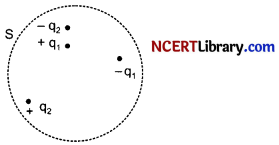
(a) due to + q2 only
(b) due to all charges
(c) zero
(d) due to positive charge only
Answer:
(c) zero
Explanation: Here total charge = q1 + q2 – q1 – q2 = 0.
So, total electric flux out of the surface is zero.
Question 2.
Figure shows some equipotential lines distributed in space. A charged object is moved from point A to point B. [1]

(a) The work done in figure (i) is the greatest
(b) The work done in figure (ii) is the least
(c) The work done is the same in figure (i), (ii) and (iii).
(d) The work done in figure (iii) is greater than figure (ii) but equal to that in figure (i).
Answer:
(c) The work done is the same in figure (i), (ii) and (iii).
Explanation: In all the three figures, VA = 20 V and VB = 40 V. Work done in carrying a charge q from A to B is W = q(VB – Va).
Question 3.
When a current I is set up in a wire of radius r, the drift velocity is vd If the same current is set up through a wire of radius 2r, the drift velocity will be: [1]
(a) 4vd
(b) 2vd
(c) vd/2
(d) vd/4
Answer:
(d) vd/4
Explanation: As we know that,
I = nAevd
or vd ∝ \(\frac{1}{\pi r^2}\)
If r → 2r, then vd’ = \(\frac{1}{\pi(2 r)^2}\)
v’d = \(\frac{v_d}{4}\)
Question 4.
A charge of 1 C is moving in a magnetic field of 0.5 T with velocity of 10 m/s. Force experienced is: [1]
(a) 0.5 N
(b) 5 N
(c) 10 N
(d) 0 N
Answer:
(b) 5 N
Explanation: Force on change due to magnetic field.
F = qυB
∴ F = 1 x 0.5 x 10
= 5 N
![]()
Question 5.
A charge particle after being accelerated through a potential difference V enters in a uniform magnetic field and moves in a circle of radius r. If V is doubled, the radius of the circle will become : [1]
(a) 2r
(b) \(\sqrt{2}\)r
(c) 4r
(d) \(\frac{1}{\sqrt{2} r}\)
Answer:
(b) \(\sqrt{2}\)r
Explanation: Radius of circular path
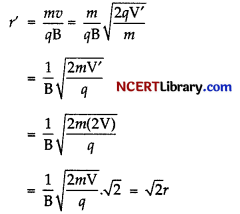
Question 6.
A paramagnetic substance is placed in a magnetic field which is increased till the magnetisation of the substance becomes constant. Now, on lowering the temperature, the magnetisation : [1]
(a) will increase
(b) will decrease
(c) will remain unchanged
(d) may increase or decrease
Answer:
(c) will remain unchanged
Explanation: Magnetisation becomes constant i.e., all the magnetic moments have got aligned in the direction of the applied field. So now, if the temperature is decreased, thermal vibration of the paramagnetic material will reduce. But as all the magnetic moments are already aligned in the direction of the field so no further alignment can take place due to reduced thermal motion. Thus, there will be no negative effect of decreasing the temperature on the magnetisation.
Question 7.
Lenz’s law gives:
(a) the direction of the induced current
(b) the magnitude of the induced emf
(c) the magnitude of the induced current
(d) both the magnitude and direction of the induced current [1]
Answer:
(a) the direction of the induced current
Explanation: Lenz’s law states that an induced electric current flows in a direction such that the current opposes the change that induced it.
Question 8.
What is the velocity of electromagnetic waves in free space? [1]
(a) c = \(\frac{1}{\mu_0 \varepsilon_0}\)
(b) c = μ0ε0
(c) c = \(\frac{1}{\sqrt{\mu_0 \varepsilon_0}}\)
(d) None of these
Answer:
(c) c = \(\frac{1}{\sqrt{\mu_0 \varepsilon_0}}\)
Explanation: As the constant μ0 and ε0 do not depend on frequency or wavelength of e.m. waves so the value of c remains same. Flence, the velocity of e.m. waves in free space is :
(c) c = \(\frac{1}{\sqrt{\mu_0 \varepsilon_0}}\)
Question 9.
An AC supply gives Vrms = 30V, which passes through 10Q resistance. The power dissipated in it is : [1]
(a) 45 \(\sqrt{2}\) W
(b) 90 \(\sqrt{2}\) W
(c) 45 W
(d) 90 W
Answer:
(d) 90 W
Explanation: We know that,
p = \(\frac{\mathrm{V}_{\mathrm{rms}}^2}{\mathrm{R}}\)
= \(\frac{(30)^2}{10}\)
= 90 W
Question 10.
A fish which is at a depth of 12 cm in water (μ = \(\frac { 4 }{ 3 }\) is viewed by an observer on the bank of a lake. Its apparent depth as observed by the observer is: [1]
(a) 3 cm
(b) 9 cm
(c) 12 cm
(d) 16 cm
Answer:
(b) 9 cm
Explanation: D = Real depth, d = apparent depth
μ = \(\frac { D }{ d }\)
d = \(\frac { D }{ μ }\) = \(\frac { 12 }{ 4/3 }\) = 9 cm
Question 11.
A potential difference of 10 V is applied across a conductor of length 0.1 m. If the drift velocity of electrons is 2 x 10-4 m/s, the electron mobility is: [1]
(a) 1 x 10-6
(b) 2 x 10-6
(c) 3 x 10-6
(d) 4 x 10-6
Answer:
(b) 2 x 10-6
Explanation: As we know that,
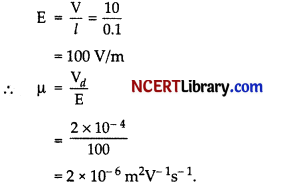
Question 12.
In the a-particle scattering experiment, the shape of the trajectory of the scattered a-particles depend upon : [1]
(a) only on impact parameter.
(b) only on the source of a-particles.
(c) both impact parameter and source of a-particles.
(d) impact parameter and the screen material of the detector.
Answer:
(a) only on impact parameter.
Explanation: In the a-particle scattering experiment, the shape of the trajectory of the scattered a-particles only depends upon impact parameters.
Question 13.
The forbidden energy band gap in conductors, semiconductors and insulators are Eg1, Eg2, and Eg3 respectively. The relation among them is : [1]
(a) Eg1 = Eg2 = Eg3
(b) Eg1 < Eg2 < Eg3
(c) Eg1 > Eg2 > Eg3
(d) Eg1 < Eg2 > Eg3
Answer:
(b) Eg1 < Eg2 < Eg3
Explanation: Band gap of the insulator is largest as it restricts the flow of electrons through it.
So, Eg1 < Eg2 < Eg3
Question 14.
The rms value of an AC of 50 Hz is 10 A. The time taken by the alternating current in reaching from zero to maximum value and the peak value of current will be: [1]
(a) 1 x 10-2 s and 7.07 A
(b) 2 x 10-2 s and 14.14 A
(c) 5 x 10-3 s and 14.14 A
(d) 5 x 10-3 s and 7.07 A
Answer:
(c) 5 x 10-3 s and 14.14 A
Explanation: Time taken by the current to reach the maximum value.
t = \(\frac { T }{ 4 }\)
= \(\frac { 1 }{ 4f }\)
= \(\frac { 1 }{ 4×50 }\)
= 5 x 10-3 s
I0 = Irms\(\sqrt{2}\)
= 10\(\sqrt{2}\)
= 14.14 A.
![]()
Question 15.
An electric dipole is placed at the centre of a hollow conducting sphere. Which of the following is correct? [1]
(a) Electric field is zero at every point of the sphere
(b) Electric field is not zero anywhere on the sphere
(c) The flux of electric field is not zero through the sphere
(d) None of the above
Answer:
(b) Electric field is not zero anywhere on the sphere
Explanation: When electric dipole is held in the sphere, electric field is not zero anywhere on the sphere. However, net electric flux through the sphere is zero.
(Direction: Question 16 to 18) Two statements are given-one labelled Assertion (A) and the other labelled Reason (R). Select the correct answer to these questions from the codes (a), (b), (c) and (d) as given below:
(a) Both A and R are true and R is the correct explanation of A.
(b) Both A and R are true and R is not the correct explanation of A.
(c) A is true, but R is false.
(d) A is false, and R is also false.
Question 16.
Assertion: Semiconductors do not obeys Ohm’s law. [1]
Reason: Current can not be determined by the rate of flow of charge carriers.
Answer:
(d) A is false, and R is also false.
Explanation: The assertion is not true. In fact, semiconductor obeys Ohm’s law for low values of electric field (~ 106 V/m). Above this, the current becomes almost independent of electric field.
Hence, assertion is false and reason is also false.
Question 17.
Assertion: Optical fibres make use of total internal reflection. [1]
Reason: Light undergoes successive total internal reflections as it moves through an optical fibre.
Answer:
(b) Both A and R are true, but R is not the correct explanation of A.
Explanation: Optical fibres are fabricated with high quality composite glass or quartz fibres. Each fibre consists of a core and cladding. The refractive index of the material of the core is higher than that of the cladding. When a signal in the form of light is directed at one end of the fibre at a suitable angle, it undergoes repeated total internal reflections along the length of the fibre and finally comes out at the other end.
Question 18.
Assertion : Kirchhoff’s junction rule can be applied to a junction of several lines or a point in a line. [1]
Reason: When steady current is flowing, there is no accumulation of charges at any junction or at any point in a line.
Answer:
(a) Both A and R are true and R is the correct explanation of A.
Explanation: Junction rule or Kirchhoff’s first law or Kirchhoff’s current law (KCL) states that the algebraic sum of the currents meeting at a junction (point) in an electrical circuit is always zero. Or, the sum of currents flowing towards the junction is equal to sum of currents leaving the junction.
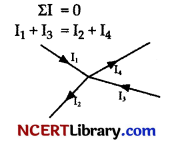
Section – B
Question 19.
Name the parts of the electromagnetic spectrum which is: [2]
(i) suitable for radar systems used in aircraft navigation
(ii) used to treat muscular strain
(iii) used as a diagnostic tool in medicine Write in brief, how these waves can be produced.
Answer:
(i) Microwaves are suitable for radar systems that are used in aircraft navigation.
These rays are produced by special vacuum tubes, namely klystrons, magnetrons and Gunn diodes.
(ii) Infrared waves are used to treat muscular strain. These rays are produced by hot bodies and molecules.
(iii) X-rays are used as a diagnostic tool in medicine. These rays are produced when high energy electrons are stopped suddenly on a metal of high atomic number.
Question 20.
Two charges 2 μC and – 2 μC are placed at points A and B 6 cm apart. [2]
(i) Identify an equipotential surface of the system.
(ii) What is the direction of the electric field at every point on this surface ?
Answer:
The situation is represented in the given figure.
(i) An equipotential surface is the plane on which total potential is zero everywhere. This plane is normal to line AB. The plane is located at the mid-point of line AB because the magnitude of charges is the same.
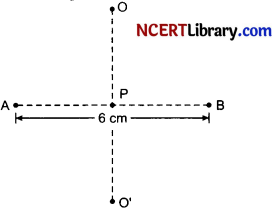
(ii) The direction of the electric field at every point on this surface is normal to the plane in the direction of AB.
Question 21.
A nucleus with mass number A = 240 and BE/A = 7.6 MeV breaks into two fragments each of A = 120 with BE/A = 8.5 MeV. Calculate the released energy. [2]
OR
Distinguish between nuclear fission and nuclear fusion.
Answer:
Binding energy of the nucleus,
B1 = 7.6 x 240 = 1824 MeV.
Binding energy of each product nucleus,
B2 = 8.5 x 120 = 1020 MeV
Then, energy released as the nucleus breaks,
E = 2B2 – B1 = 2 x 1020 – 1824 = 216 MeV.
OR
| Nuclear fission | Nuclear fusion |
| (i) It is the process in which a heavy nucleus split up into two lighter nuclei of nearly equal masses. | It is the process in which two lighter nuclei combine together to form a heavy nucleus. |
| (ii) Comparatively less amount of energy is released. | Enormous amount of energy is released. |
| (iii) Nuclear fission may take place at ordinary temperature. | A very high temperature of the order of million of degree is required. |
| (iv) The sources of fissionable materials is limited. | The sources of fusion reaction i.e., hydrogen is more plentiful (air and water). |
| (v) The products of nuclear fission are in general radioactive and hence pose a radiation hazard. | The products of fusion are non-radioactive and pose no radiation hazard. |
Question 22.
Two monochromatic rays of light are incident normally on the face AB of an isosceles right-angled prism ABC. The refractive indices of the glass prism for the two rays ‘Y and “2! are respectively 1.35 and 1.45. Trace the path of these rays after entering through the prism. [2]
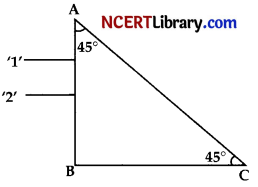
Answer:
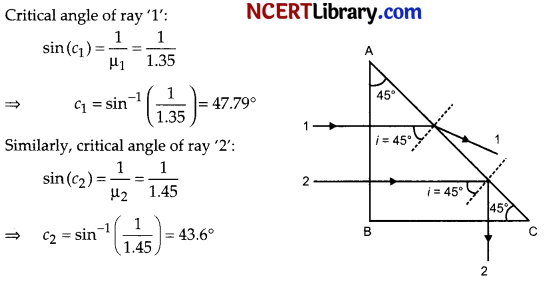
Ray ‘1’ and ‘2’ will fall on the side AC at an angle of incidence (;) of 45°. Critical angle of ray ‘V is greater than i, so it will get refracted from the prism. Critical angle of ray ‘2’ is less than that of i, so it will undergo total internal reflection.
Question 23.
Draw the equipotential surfaces due to an electric dipole. Locate the points where the potential due to the dipole is zero. [2]
OR
Find the ratio of the potential differences that must be applied across the parallel and series combination of two capacitors C1 and C2 with their capacitances in the ratio 1 : 2 so that the energy stored in the two cases becomes the same.
Answer:
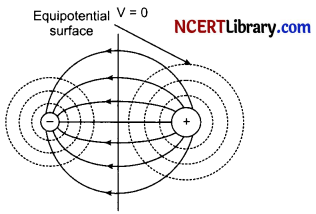
The potential will be zero at equatorial plane of electric dipole going through the centre of dipole.
OR
Given, C1 : C2 = 1 : 2
⇒ C2 = 2C1
For parallel combination of capacitor,
Cp = C1 + C2
= C1 + 2C1 = 3C1
The energy stored in capacitor,
Ep = \(\frac { 1 }{ 2 }\)CpV²p
= \(\frac { 1 }{ 2 }\) x 3C1 V²p = \(\frac { 3 }{ 2 }\) C1V²2 … (i)
For series combination of capacitor,
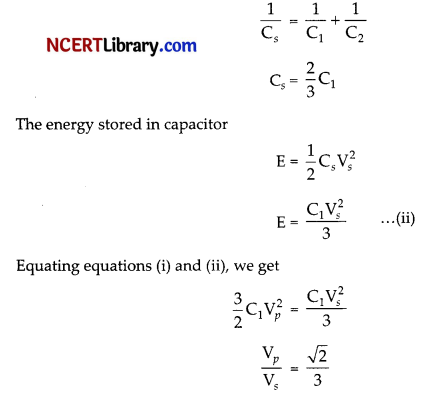
Question 24.
Find the radius of curvature of the convex surface of the plano-convex lens, whose focal length is 0.3 m and the refractive index of the material of the lens is 1.5. [2]
Answer:
Here, f = 0.3 m = 30 cm
R1 = ∞ (for plane surface)
R2 = ?
μ = 1.5
∴ \(\frac{1}{f}=(\mu-1)\left(\frac{1}{R_1}-\frac{1}{R_2}\right)\)
⇒ \(\frac{1}{30}=(1.5-1)\left(\frac{1}{\infty}-\frac{1}{\mathrm{R}_2}\right)\)
⇒ \(\frac{1}{30}=0.5\left(-\frac{1}{\mathrm{R}_2}\right)\)
⇒ R2 = – 0.5 x 30 = – 15 cm
∴ Radius of curved surface = 15 cm.
![]()
Question 25.
(i) Explain the formation of energy bands in crystalline solids. [2]
(ii) Draw the energy band diagrams of (a) a metal and (b) a semiconductor.
Answer:
(i) An enormously large number of energy levels closely spaced in a very small energy range constitute an energy band.
The allowed energy bands are separated by regions in which energy levels cannot exist. These forbidden regions are called band gaps or energy gaps.
The highest energy band occupied by the valence electrons is called the valence band and the next empty allowed band is called the conduction band.
(ii) (a)
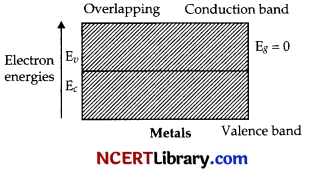
(b)
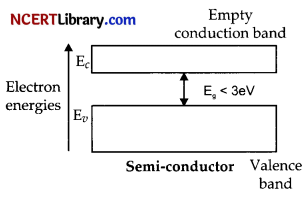
Section – C
Question 26.
An observer to the left of a solenoid of N turns each of cross-section area A observes that a steady current I in it flows in the clockwise direction. Depict the magnetic field lines due to the solenoid specifying its polarity and show that it acts as a bar magnet of magnetic momentum M = NIA. [3]

Answer:
Given that the current flows in the clockwise direction for an observer on the left side of the solenoid. This means that left face of the solenoid acts as south pole and right face acts as north pole. Inside a bar magnet the magnetic field lines are directed from south to north. Therefore, the magnetic field lines are directed from left to right in the solenoid.
Magnetic moment of single current carrying loop is given by m’ = IA
Where, I = Current flowing through the loop
A = Area of the loop
So, Magnetic moment of the whole solenoid is given by
M = Nm’ = N (IA)
Question 27.
Four point charges Q, q, Q and q are placed at the comers of a square of side V as shown in the figure. Find the: [3]
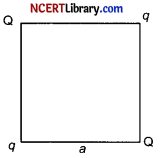
(i) resultant electric force on a charge Q, and
(ii) potential energy of this system.
Answer:
(i) Force on charge Q at B due to charge q
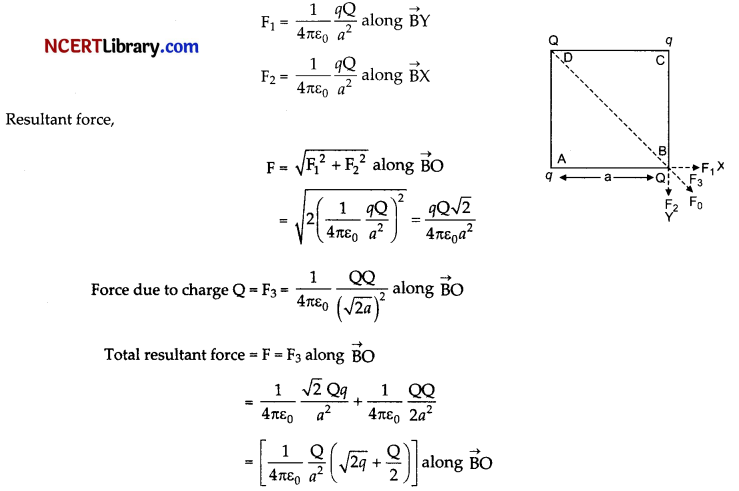
(ii) Total potential energy of the system.
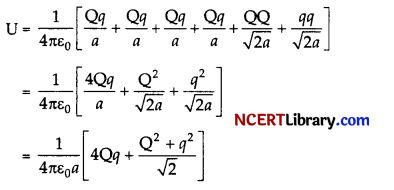
Question 28.
As shown in fig. an electric lamp having coil of negligible inductance connected in series with a capacitor and an a.c. source is glowing with certain brightness. [3]
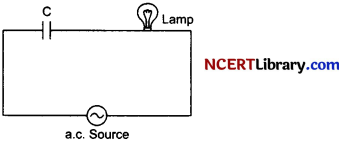
How does the brightness of the lamp change on reducing
(i) the capacitance and
(ii) the frequency?
Justify your answer.
OR
Three students X, Y and Z performed an experiment for studying the variation of alternating currents with angular frequency in a series LCR-circuit and obtained the graphs shown in fig.
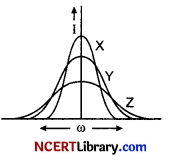
They all used a.c. sources of the same r.m.s. value and inductances of the same value. What can we (qualitative) conclude about the (i) capacitance value (ii) resistance values used by them? In which case will the quality factor be maximum? What can we conclude about nature of the impedance of the set up at frequency ω0?
Answer:
Now, capacitive reactance,
χC = \(\frac{1}{2 \pi f C}\)
If E is e.m.f. of the source, then current through the lamp,
I – \(\frac{\mathrm{E}}{\mathrm{X}_{\mathrm{C}}}=\frac{\mathrm{E}}{1 / 2 \pi f C}=2 \pi f \mathrm{CE}\)
(i) When the capacitance (C) is decreased, it follows that current through the lamp will decrease and hence the brightness of the lamp will decrease.
(ii) When the frequency of the source (/) is decreased, it will also decreases the current through the lamp and hence the brightness of the lamp will decrease.
OR
(i) The angular resonant frequency is given by
ω0 = \(\frac{1}{\sqrt{\mathrm{LC}}}\)
Since all the three students have used inductances of the same value, the capacitors used by them must be of the same values of capacitance.
(ii) Since peak values of the alternating currents obtained by them are different, the resistors used by them are of different values of resistance. As the peak value of the currents differ as shown in the figure, Rz > Ry > Rx.
Now, quality factor,
Q = \(\frac{\omega_0 \mathrm{~L}}{\mathrm{R}}\)
It follows that the quality factor will be maximum for the observation made by the student X.
At the resonant frequency, the impedance of the circuit is equal to the resistance of the circuit. Therefore, in all three cases, impedance will be different i.e., Zz > ZY > Zx.
Question 29.
(a) Define the term drift velocity. [3]
(b) On the basis of electron drift, derive an expression for resistivity of a conductor in terms of number density of free electrons and relaxation time. On what factors does resistivity of a conductor depend?
(c) Why alloys like constantan and manganin are used for making standard resistors?
OR
Two cells of emfs 1.5 V and 2.0 V having internal resistances 0.2 Ω and 0.3 Ω respectively are connected in parallel. Calculate the emf and internal resistance of the equivalent cell.
Answer:
(a) Drift velocity is defined as the average velocity with which the free electrons are drifted towards the positive terminal under the effect of applied electric field. Thermal velocities are randomly distributed and average thermal velocity is zero.

(b) We know that the current flowing through the conductor is:
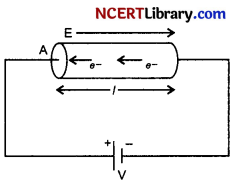
I ∝ V → by Ohm’s law
Where, R = \(\frac{m l}{n \mathrm{~A} e^2 \tau}\) is a constant for a particular conductor at a particular temperature and is called the resistance of the conductor.
R = \(\left(\frac{m}{n e^2 \tau}\right) \frac{l}{\mathrm{~A}}=\frac{\rho l}{\mathrm{~A}}\)
ρ = \(\left(\frac{m}{n e^2 \tau}\right)\)
Where ρ is the specific resistance or resistivity of the material of the wire. It depends on number of free electron per unit volume and temperature.
(c) They are used to make standard resistors because:
(i) They have high value of resistivity.
(ii) Temperature coefficient of resistance is less.
(iii) They are least affected by temperature.
OR
Given,
Equivalent emf,
E1 = 1.5 V, r1 = 0.2 Ω, E2 = 2 V, r2 = 0.3 Ω

Question 30.
Explain the formation of potential barrier and depletion region in a p-n junction diode. What is the effect of applying forward bias on the width of depletion region? [3]
Answer:
Two important processes involved during the formation of p-n junction are diffusion and hole. Formation of depletion region and potential barrier: At the instant of p-n junction formation, the free electrons near the junction diffuse across the junction into the p-region and combines with holes. Thus, on combining with the hole, it makes a negative ion and leaves a positive ion on w-side. These two layers of immobile positive and immobile negative charges form the depletion charge.
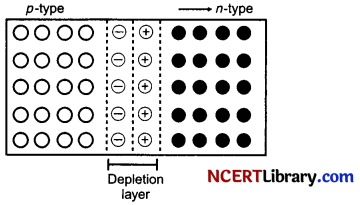
Further, as electrons diffuse across the junction, a point is reached where the negative charge repels only further diffusion of electron. This depletion region now acts as a barrier. Now, the external energy is supplied to get electrons to move across the barrier of electric field.
The potential difference required to move the electron through the electric field is called barrier potential. The effect of forward bias on p-n region is that the depletion layer will be reduced.
Section – D
Question 31.
(a) (i) State Biot-Savart law and express this law in the vector form. [5]
(ii) Two identical circular coils, P and Q each of radius R, carrying currents 1A and V3 A respectively,
are placed concentrically and perpendicular to each other lying in the XY and YZ planes. Find the magnitude and direction of the net magnetic field at the centre of the coils.
(b) Write Ampere’s circuital law. State its one application.
OR
(a) Derive the expression for the force acting between two long parallel current carrying conductors. Hence, define 1 A current.
(b) A bar magnet of dipole moment 3 Am2 rests with its centre on a frictionless pivot. A force F is applied at right angles to the axis of the magnet, 10 cm from the pivot. It is observed that an external magnetic field of 0.25 T is required to hold the magnet in equilibrium at an angle of 30° with the field.
Calculate the value of F.
How will the equilibrium be effected if F is withdrawn?
Answer:
(a) (i) Biot-Savart Law: It states that the magnetic field strength (dB) produced due to a current element I and length dl at a point having position vector \(\vec{r}\) relative to current element is
- directly proportional to the current I, i.e., dB ∝ I.
- directly proportional to the length dl of the element i.e., dB ∝ dl.
- directly proportional to sin θ, where θ is the angle between dl and r, i.e., dB ∝ sin θ.
- inversely proportional to the square of the distance r from the current element

(ii) We know that,
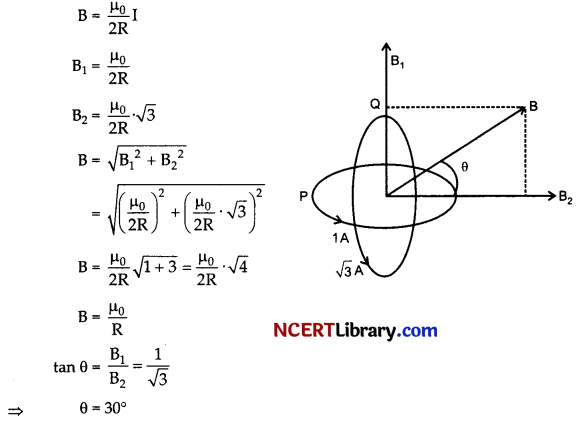
(b) The line integral of the magnetic field along any closed path is equal to μ0 times the current enclosed by the path.
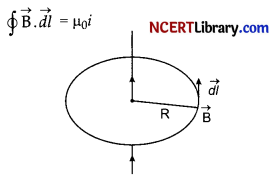
Application of Ampere’s circuital law:
Magnetic field at a point due to a long straight wire-Assume a long straight wire carrying a current i, P is point at a distance ‘R’ from the wire. B is the magnetic field at point P.
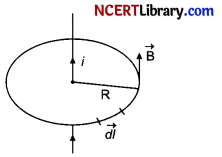
As per Ampere circuital law, we have
\(\oint\) B.dl = μ0i
Amperian loop at P-Here it is a circle of radius R.
Since B is constant at any point on the loop,
B\(\oint\) dl = μ0i
⇒ B x 2πR = μ0i
B = \(\frac{\mu_0 i}{2 \pi R}\)
The direction of the magnetic field is found by right hand thumb rule.
Curl the fingers of the right hand with thumb extended and hold the wire such that the thumb is along the direction of the current, then the curled fingers give the direction of the magnetic field at any point.
OR
(a) Suppose two long thin straight long conductors (or wires) PQ and RS are place parallel to each other, carrying current I1 and I2 respectively. When the current flow in same direction they experience an attractive force and when they carry current in opposite directions, they experience repulsive force.
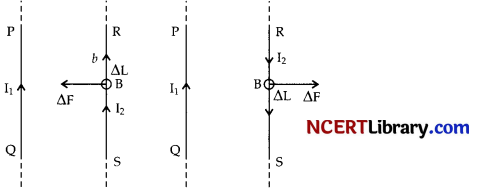
Consider a current element ∆L of wire RS. The magnetic field produced by current carrying conductor PQ at the location of other wire RS.
According to Maxwell’s right hand rule the direction of magnetic field will be perpendicular to the plane of the people.
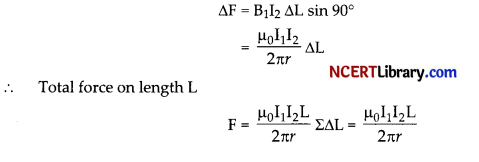
∴ Force acting on per unit length of conductor
f = \(\frac { F }{ L }\) = \(\frac{\mu_0 \mathrm{I}_1 \mathrm{I}_2}{2 \pi r} \mathrm{~N} / \mathrm{m}\)
Thus, 1 ampere is defined as the current which when flow in each of the parallel conductors placed at separation of 1 m in vacum exerts a force of 2 x 10-7 N on 1 m length of either wire.
(b) Dipole moment, M = 3 Am²
External magnetic field,
B = 0.25T
Angle of field,
θ = 30°
Distance of which force applied from pivot,
r = 10 cm = 0.10 m
As magnetic bar is in equilibrium under external force.
Now, τForce = τM.F.
⇒ \(\vec{F}\) x \(\vec{r}\) = MB sin θ
⇒ F x r x sin 90° = 3 x 0.25 x sin 30°
⇒ F = \(\frac{3 \times 0.25}{0.10} \times \frac{1}{2}\)
= \(\frac { 75 }{ 20 }\) = 3.75 N
If F will be removed then it will not remain in equilibrium and start rotating around its pivot.
![]()
Question 32.
(a) (i) Describe briefly three experimentally observed features in the phenomenon of photoelectric effect. [5]
(ii) Discuss briefly how wave theory of light cannot explain these features.
(b) Using photon picture of light, show how Einstein’s photoelectric equation can be established. Write two features of photoelectric effect which cannot be explained by wave theory.
OR
(a) Why photoelectric effect cannot be explained on the basis of wave nature of light? Give reasons.
(b) Write the basic features of photon picture of electromagnetic radiation on which Einstein’s photoelectric equation is based.
Answer:
(a) (i) 1. The photoelectric effect will not occur when the frequency of the incident light is less than the threshold frequency. Different materials have different threshold frequencies and most elements have threshold frequencies in the ultraviolet region of the electromagnetic spectrum.
2. The maximum kinetic energy of a stream of photoelectrons increases linearly with the frequency of the incident light above the threshold frequency.
3. The rate at which photoelectrons are emitted from a photosensitive surface is directly proportional to the intensity of the incident light when the frequency is constant.
(ii) Classical wave theory cannot explain:
1. The existence of threshold frequency because it predicts that electrons would absorb enough energy to escape and there would not be any threshold frequency.
2. The almost immediate emission of photoelectrons as, according to this theory, electrons require a period of time before sufficient energy is absorbed by it to escape from the metal; however, such a thing does not happen practically.
3. The independence of KE of photoelectrons on intensity and dependence on frequency because it cannot explain why maximum KE is dependent on the frequency and independent of intensity. Einstein’s photoelectric equation : Einstein explained the various laws of photoelectric emission on the basis of Planck’s quantum theory. According to Planck’s quantum theory, light radiations consist of tiny packets of energy called ‘quanta’. One quantum of light radiation is called a photon which travels with the speed of light.
The energy of a photon is given by,
E = hv
where, h is Planck’s constant and v is the frequency of light radiation.
Einstein assumed that one photoelectron is ejected from a metal surface, if one photon of suitable light radiation falls on it.
Consider a photon of light of frequency v, incident on a photosensitive metal surface. The energy of the photon (= hv) is spent in two ways :
(1) A part of the energy of the photon is used in liberating the electron from the metal surface which is equal to the work function Φ0 of the metal.
(2) The rest of the energy of the photon is used in imparting the maximum kinetic energy Kmax to the emitted photoelectron.
If υmax is the maximum velocity of the emitted photoelectron and m is its mass, then maximum kinetic energy of the photoelectron is,
Kmax = \(\frac { 1 }{ 2 }\) mv²max
∴ hv = Φ0 + \(\frac { 1 }{ 2 }\) mυ²max
This equation is called Einstein’s photoelectric equation.
Features of photoelectric effect which can not be explained by wave theory:
(a) The wave theory could not explain the instantaneous process of photoelectric effect.
(b) It could not explain, why the photoelectric emission is independent of intensity.
OR
(a) Wave nature of radiation cannot explain the following:
- The immediate ejection of photoelectrons.
- The presence of threshold frequency for a metal surface.
- The fact that kinetic energy of the emitted electrons is independent of the intensity of light and depends upon its frequency.
Thus, the photoelectric effect cannot be explained on the basis of wave nature of light.
(b) Photon picture of electromagnetic radiation on which Einstein’s photoelectric equation is based on particle nature of light.
Its basic features are:
(1) In interaction with matter, radiation behaves as if it is made up of particles called photons.
(2) Each photon has energy (E = hv), momentum (p = \(\frac { hv }{ c }\) where c is the speed of light
(3) All photons of light of a particular frequency v, or wavelength X, have the same energy (E = hv = \(\frac { hc }{ λ }\))
and momentum (p = \(\frac { hv }{ c }\))
(4) By increasing the intensity of light of given wavelength, there is only an increase in the number of photons emitted per second crossing a given area, with each photon having the same energy. Thus, photon energy is independent of intensity of radiation.
(5) Photons are electrically neutral and are not deflected by electric and magnetic fields.
(6) In a photon-particle collision (such as photon-electron collision), the total energy and total momentum are conserved. However, number of photons may not be observed.
Question 33.
(a) ”Two independent monochromatic sources of light cannot produce a sustained interference pattern.” Give reasons. [5]
(b) Two coherent light waves of intensity 5 x 10-2 Wm-2 each superimpose and produce the interference pattern on a screen. At a point where the path difference between the waves is X/6, X being wavelength of the wave, find the
(i) phase difference between the waves.
(ii) resultant intensity at the point.
(iii) resultant intensity in terms of the intensity at the maximum.
OR
(a) If one of two identical slits producing interference in Young’s experiment is covered with glass, so that the light intensity passing through it is reduced to 50%, find the ratio of the maximum and minimum intensity of the fringe in the interference pattern.
(b) What kind of fringes do you expect to observe if white light is used instead of monochromatic light? [5]
Answer:
(a) The condition for the sustained interference is that both the sources must be coherent (i.e., they must have the same wavelength and the same frequency and they must have the same phase or constant phase difference).
Two sources are monochromatic if they have the same frequency and wavelength. Since, they are independent, i.e., they have different phases with irregular difference, they are not coherent sources.
(b) Here, I1 = I2 = 5 x 10-2 Wb/m²
Here path difference = λ/6
(i) Phase difference = \(\frac { 2π }{ λ }\) x Path difference
= \(\frac { 2π }{ λ }\) x \(\frac { λ }{ 6 }\) = \(\frac { π }{ 3 }\)
(ii) Resultant Intensity,
I = I1 + I2 + 2\(\sqrt{\mathrm{I}_1 \mathrm{I}_2} \cos \phi\)
= 5 x 10-2 + 5 x 10-2 + 2\(\sqrt{\left(5 \times 10^{-2}\right)^2}\) cos \(\frac { π }{ 3 }\)
= 2 x 5 x 10-2 + 2 x 5 x 10-2 cos 60°
= 10 x 10-2 + 5 x 10-2
= 15 x 10-2 Wb/m²
(iii) The intensity is maximum when phase difference is an integral multiple of 2π
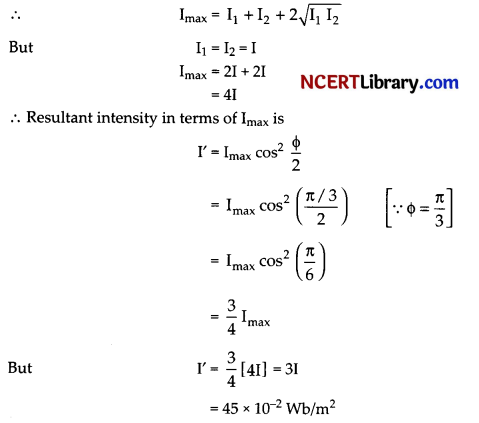
OR
(a) The resultant intensity in Young’s experiment is given by
IR = I1 + I2 + 2 \(\sqrt{I_1 I_2} \cos \phi\)
When slit is not covered, then Io is the intensity from each slit.
Maximum intensity (Imax) occurs when Φ = 0°.
Minimum intensity (Imin) occurs when Φ = 180°.
If one slit is covered with glass to reduce its intensity by 50%, then
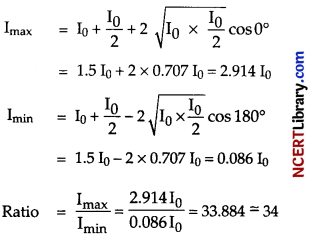
(b) If instead of monochromatic light, white light is used, then the central fringe will be white and the fringes on either side will be coloured. Blue colour will be nearer to central fringe and red will be farther away. The path difference at the centre on perpendicular bisector of slits will be zero for all colours and each colour produces a bright fringe thus resulting in white fringe. Further, the shortest visible wave, blue, produces a bright fringe first.
Section – E
Question 34.
Case Study:
Read the following paragraph and answer the questions.
The most important parameter while we discuss a lens is its focal length. It is to be noted that focal length may not the same for all rays, even if the lens and the surrounding medium remain the same. Different wavelengths may focus on different points depending on the deviation produced by refraction in the lens. Shorter wavelengths deviate more while longer wavelengths suffer less deviation. [4]
As for parallel rays, they converge to a single point on the other side of the lens. But this happens only when the medium surrounding the lens is rarer. If the surrounding medium is denser than the meterial of the lens, then convex lens behaves as a diverging lens.
The image formed by a convex lens (when placed in air) is located depending on the positions of the object. When the object moves from infinity to the focus (on the same side as the object), the image moves from the focus (on the other side) to infinity. The object and image distance will be equal if the object is placed at a distance 2F from the lens, where F is the focal length. If the object is placed between the focus and the lens, then a virtual image is formed behind the lens.
Here is a scaled diagram, with AB = BO = OF = FC = CD. Presently air surrounds the lens. F is the focal point for green ray.
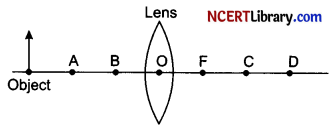
Based on the description and the diagram shown, answer the following questions:
(i) Where will be the image of the shown object be formed?
(ii) Write the nature of the image.
(iii) If the object is placed at A, where will the image be formed?
OR
(iii) If red rays are emanating from the object and falls on the lens parallel to the principal axis, then where will they converge? (consider, all wavelengths do not focus to the same points)
Answer:
(i) Between F and C
The object is beyond 2F, image will be between F and 2F.
(ii) Real, inverted image is formed.
(iii) At C image will be formed.
Point A is at 2F from w.r.t. O.
OR
(iii) Slightly to the right of F
Red rays suffer less deviation.
Question 35.
Case Study:
Read the following paragraph and answer the questions. [4]
In accordance with Einstein’s famous equation, E = me2. In this equation, E denotes the energy carried by a particle because of its mass. The particle can have additional energy due to its motion and its interactions with other particles. Consider a neutron at rest decays into a proton, an electron and an undetected third particle as given here:
Neutron → proton + electron + ???
The table summarizes some data from a single neutron decay given below:
| Particle | Mass x c² (MeV) | Kinetic energy (MeV) |
| Neutron | 940.97 | 0.00 |
| Proton | 939.67 | 0.01 |
| Electron | 0.51 | 0.39 |
(i) From the given table, which properties of the undetected third particle can be calculate?
(ii) Assuming the table contains no major errors, what can we conclude about the (mass x c²) of the undetected third particle?
(iii) Could this reaction occur?
Proton → neutron + other particles
OR
(iii) How much mass has to be converted into energy to produce electric power of 500 MW for one hour?
Answer:
(i) Total energy but not kinetic energy
(ii) It is less than or equal to 0.49 MeV; but we cannot be more precise.
(iii) Yes, but only if the proton has potential energy (due to interactions with other particles).
OR
(iii) P = \(\frac { E }{ t }\)
E = 500 x 106 x 3600
= 1.8 x 1012
But E = mc²
m = \(\frac { E }{ c² }\)
= \(\frac{1.8 \times 10^{12}}{\left(3 \times 10^8\right)^2}\)
= \(\frac{1.8 \times 10^{12}}{9 \times 10^{16}}\)
= 2 x 10-5 kg